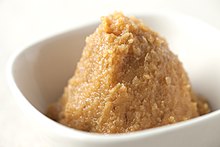
Back ميسو Arabic Miso Azerbaijani Міса BE-X-OLD Мисо Bulgarian Miso Catalan Miso Czech Miso Danish Miso German Μίσο Greek Misoo Esperanto
 Miso | |
| Alternative names | Soybean paste, 味噌 (Japanese) |
|---|---|
| Type | Seasoning |
| Place of origin | Japan |
| Associated cuisine | Japanese |
| Main ingredients | Fermented soybeans, salt, kōji (Aspergillus oryzae) |


| Nutritional value per 100 g (3.5 oz) | |
|---|---|
| Energy | 831 kJ (199 kcal) |
26.47 | |
| Sugars | 6.2 |
| Dietary fiber | 5.4 |
6.01 | |
| Saturated | 1.139 |
| Monounsaturated | 1.242 |
| Polyunsaturated | 3.204 |
11.69 | |
| Tryptophan | 0.155 g |
| Threonine | 0.479 g |
| Isoleucine | 0.508 g |
| Leucine | 0.82 g |
| Lysine | 0.478 g |
| Methionine | 0.129 g |
| Cystine | 0 g |
| Phenylalanine | 0.486 g |
| Tyrosine | 0.352 g |
| Valine | 0.547 g |
| Arginine | 0.784 g |
| Histidine | 0.243 g |
| Alanine | 0.5 g |
| Aspartic acid | 1.171 g |
| Glutamic acid | 1.915 g |
| Glycine | 0.447 g |
| Proline | 0.619 g |
| Serine | 0.601 g |
| Vitamins | Quantity %DV† |
| Vitamin A equiv. | 0% 4 μg0% 52 μg0 μg |
| Thiamine (B1) | 8% 0.098 mg |
| Riboflavin (B2) | 18% 0.233 mg |
| Niacin (B3) | 6% 0.906 mg |
| Pantothenic acid (B5) | 7% 0.337 mg |
| Vitamin B6 | 12% 0.199 mg |
| Folate (B9) | 5% 19 μg |
| Vitamin B12 | 3% 0.08 μg |
| Choline | 13% 72.2 mg |
| Vitamin C | 0% 0 mg |
| Vitamin D | 0% 0 IU |
| Vitamin E | 0% 0.01 mg |
| Vitamin K | 24% 29.3 μg |
| Minerals | Quantity %DV† |
| Calcium | 4% 57 mg |
| Iron | 14% 2.49 mg |
| Magnesium | 11% 48 mg |
| Manganese | 37% 0.859 mg |
| Phosphorus | 13% 159 mg |
| Potassium | 7% 210 mg |
| Sodium | 162% 3728 mg |
| Zinc | 23% 2.56 mg |
| Other constituents | Quantity |
| Water | 50 |
| Alcohol (ethanol) | 0 |
| †Percentages estimated using US recommendations for adults,[1] except for potassium, which is estimated based on expert recommendation from the National Academies.[2] | |
Miso (みそ or 味噌) is a traditional Japanese seasoning. It is a thick paste produced by fermenting soybeans with salt and kōji (the fungus Aspergillus oryzae) and sometimes rice, barley, seaweed, or other ingredients. It is used for sauces and spreads, pickling vegetables, fish, or meats, and mixing with dashi soup stock to serve as miso soup, a Japanese culinary staple. Miso is high in protein and rich in vitamins and minerals, and it played an important nutritional role in feudal Japan. Miso is still widely used in both traditional and modern cooking in Japan and has been gaining worldwide interest.[3]
Typically, miso is salty, but its flavor and aroma depend on the ingredients and fermentation process. Different varieties of miso have been described as salty, sweet, earthy, fruity, and savory.
- ^ United States Food and Drug Administration (2024). "Daily Value on the Nutrition and Supplement Facts Labels". Retrieved 2024-03-28.
- ^ National Academies of Sciences, Engineering, and Medicine; Health and Medicine Division; Food and Nutrition Board; Committee to Review the Dietary Reference Intakes for Sodium and Potassium (2019). Oria, Maria; Harrison, Meghan; Stallings, Virginia A. (eds.). Dietary Reference Intakes for Sodium and Potassium. The National Academies Collection: Reports funded by National Institutes of Health. Washington, DC: National Academies Press (US). ISBN 978-0-309-48834-1. PMID 30844154.
- ^ Global Miso Market 2018-2022 (Technical report). Research and Markets. 27 March 2018. IRTNTR21132. Retrieved 20 September 2018.
© MMXXIII Rich X Search. We shall prevail. All rights reserved. Rich X Search